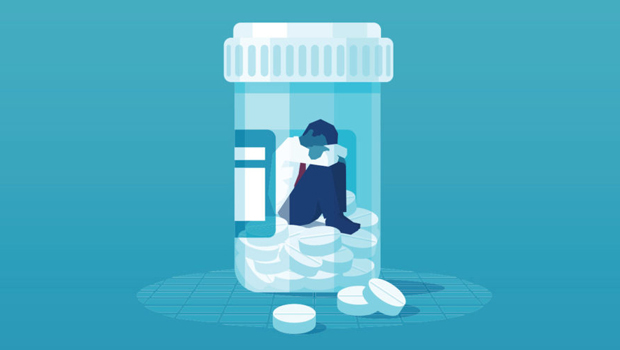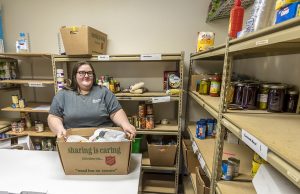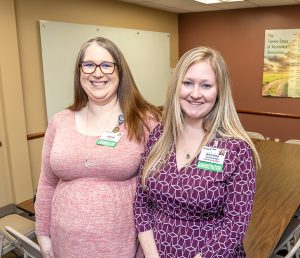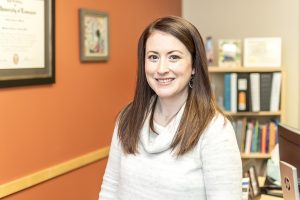

Substance abuse touches all of our lives in one way or another. Here, Aberdeen professionals who deal with addiction on a daily basis discuss how the disease belongs to all of us and what we can do to help.
Forget everything you think you know about addiction. Erase the face you see in your mind when the word comes up. The way that person acts, the things they do or don’t do, their reasons for abusing drugs or alcohol—put your opinions on all of that aside. It’s not an easy thing to do. I know for me, the face of addiction used to look like someone who was homeless or someone who spent all day at a bar. Someone who had been dealt an awful hand in life and now got high just to get through the day. It was more of a shadow than a real person. I’ve come to learn, though, the truth is addiction has many faces.
We have to let go of these stereotypes we’ve put in our minds about addiction and whose problem it is because one way or another, substance abuse affects us all. Addiction doesn’t discriminate based on age, gender, race, income level, or circumstances. It doesn’t automatically mean someone is unable to hold down a job or care about their family. And the most important thing to understand is this: Addiction is not a moral issue, but a medical one.
In January, we printed a story that looked at what our city is doing well as it enters a new decade and at ways we can do even better, based on survey responses from various community members (Aberdeen: Version 2020, January/February 2020). A common theme from this survey was that Aberdeen needs more treatment options and support for those dealing with addiction. Unless you have been living on another planet, you already know South Dakota launched its infamous “Meth. We’re on it,” campaign last year. Whatever your thoughts on the wording, you should know Aberdeen echoes the same trends seen around the state when it comes to meth use. Between 2018 and 2019, drug related calls to the police department increased from 567 to 680. And the police department, both hospitals, the Journey Home, and others who work directly with addiction all agree meth is the drug they are seeing people abuse here the most, along with alcohol.
Everyone’s Disease

Alex Miller is one of three people on staff at the Journey Home in Aberdeen. The Journey Home is a sober living facility and serves a similar purpose to that of a halfway house for people recovering from drug and alcohol addictions.
“It could happen to anyone. Maybe drug abuse isn’t in your life now or in your family’s life now, but it could be someday. We’ve seen people from all walks of life become addicted to anything,” says Alex Miller. Alex is one of three people on staff at the Journey Home in Aberdeen. While the Journey Home isn’t technically a halfway house for people recovering from addiction, it serves a similar purpose. They have residents who show up at their doorsteps and those who are referred to them by treatment centers across the state as well as the criminal justice system. They are a sober house, with a zero tolerance policy for drugs and alcohol. “When people are in treatment they learn good tools on how they can live a sober life, but without support to put those tools in place, their success rate for staying sober once they leave decreases significantly,” Alex explains. All residents at Journey Home get that extra support they need before rejoining the community fully on their own. There is no time cap on how long a resident can live there, as long as they are following their program and staying sober. Alex says some people will stay six months or longer, while others as little as 60 days. Every person follows a program specific to them, most of which include learning how to identify and overcome triggers that can cause a relapse, completing a budgeting class, and continuing with outpatient treatment. Alex says, “Everyone has a curfew here of 10:00 PM, unless they are at a meeting and have fellowship afterward or are working. Everyone completes a budget class too, so once they start working again, they have a cushion of savings when they leave here. We try to plug people into as many resources in town as we can to help them—like Northeastern Mental Health Center for counseling and the Department of Labor for finding a job.” The Journey Home’s waiting list ebbs and flows. Sometimes they are full, and other times they only have three or four residents at a time.
Alex adds that addiction and mental health go hand in hand a lot of the time, and that childhood trauma is another common factor. “Most of the people we see who are addicts we try to connect them with a counselor or a therapist, or to a psychiatrist to see if there are any medications they need to be on.” She says there is one doctor of psychiatry in Aberdeen, as well as telemedicine options, but there is a need for more of these services here. In her experience, the wait time to see a psychiatrist can be months. “It’s everyone’s disease. A mental health problem can turn into a substance abuse problem for anyone.”
Addiction Is Powerful
Chief Dave McNeil says the Aberdeen Police Department saw an increase in drug-related calls and in mental health-related calls in 2019, providing further evidence the two often go together. But it’s hard to say just how many people with substance abuse issues really do come in contact with the police. Sometimes calls are about something different like theft or assault, but addiction is the underlying problem. In South Dakota prisons, over 60% of inmates are nonviolent drug offenders, with that number increasing to 80% for female inmates (Behind Bars by Jim Reese, South Dakota Magazine, January/February 2020). Chief McNeil says the Brown County jail’s statistics are likely similar to what is seen across the rest of the state. And there are some notable gaps in the system for those suffering from addiction who are arrested. “A lot of times, someone who is just getting out of prison and is on parole has limited services. If their parole officer discovers they are using drugs again, it can take months to get them into a treatment service, whether that’s because they’re on the waiting list to get in or waiting for the financial part of it to go through. During that time, their addiction doesn’t go away. Addiction is very powerful, and sadly people don’t stop using just like that.” He notes that even though Aberdeen is a small community, it needs more resources in this area. “Almost on a weekly basis we get calls from community members or businesses about people who are not able to take care of themselves, who have passed out somewhere or who have walked into the wrong house because they’re disoriented. If we encounter an intoxicated person, we take them to the hospital on a detox hold for their safety. Often times the hospital is full, so we then take them to jail on a detox hold. But they are only there long enough to get sober, and then they are out on their own again, and the underlying mental health and substance abuse issues never get dealt with. We’d like to develop more resources to help us with this, with places like Northeastern Mental Health, so people can become connected with a counselor before they leave detox or at least have an appointment set up for later on.”
Both the Journey Home and the Police Department also acknowledge the work of Aberdeen’s Drug Court. In this court-supervised program, nonviolent drug offenders go through a five-phase plan of action that includes treatment, support groups, and drug testing instead of jail time. Completing all five phases takes months and requires participants to maintain housing, employment, and a recovery network. Alex says Drug Court is a big time commitment that takes a lot of work, but it’s worth it. “As they go through each phase, they get more freedom and also just more confidence and tools to live a sober life in the community.”
Treatable, But Not Curable

Jamie Milbrandt, certified addiction counselor (left), and Kelli Fischer, chief nursing officer, with Avera say they work with each patient on an individual basis to get them the best treatment possible. For some, that means a residential treatment stay. For others, outpatient treatment options are available.
A quick scan through the newspaper’s calendar shows almost daily options for attending both Narcotics Anonymous and Alcoholics Anonymous meetings. These free groups provide a lifetime of support, which is exactly what it takes to manage an addiction. Jamie Milbrandt, a certified addiction counselor at Avera, uses the analogy of comparing addiction to diabetes to help people better understand the disease. “If you have diabetes, it is a lifetime of adjustment and a lifetime of care in that you always have to be on top of your medications and your diet. The same is true with addiction. You can’t just go through treatment and then find yourself cured. You’ll always have to do a lot of self-care and checking in with your support groups.” Rachel Cantrell, an integrated health therapist at Sanford, adds that relapse is part of the treatment when dealing with addiction. “The majority of people with an addiction relapse at some point, whether it’s soon after treatment or years down the road. Loved ones should be aware of this and ready for it when it happens. Addiction can be managed, but not cured.”
Avera’s Addiction Care Center provides residential (similar to inpatient) and outpatient treatment options, both of which include aftercare programs. Kelli Fischer, chief nursing officer, says they rarely see patients pay out of pocket. Most insurances have some kind of behavioral health coverage, and if you don’t have insurance, there is funding available through the state and also the court system. Fear of change and denial are other blocks that people put up that prevent them from seeking treatment. The thought of being away from work and family can also deter them from committing to their wellness. Jamie says that’s where they have to get creative in working with patients. They help them with things like figuring out if they can do outpatient treatment and not have to miss out on their income, or finding out if their work offers a medical leave for them to be away at residential treatment. For people living in rural areas, sometimes residential treatment is better than outpatient because they’re not able to travel back and forth to Aberdeen several times a week. Jamie adds, “It’s a diagnosis that takes work. You have to do your steps to be successful.”
What We Can Do
Meetings, treatment options, and support programs are important, but what about prevention? It’s a huge piece of the puzzle, and it starts with taking care of our youth. There is outpatient treatment available for young people in Aberdeen, but there is not a juvenile inpatient or residential treatment center here. This means children with crippling addictions that require inpatient services have to be referred out of town. Of Avera’s dozen behavioral health and addiction counselors, two work full time inside the Aberdeen school system. Their job is to educate students, teachers, and parents on addiction before it becomes an issue. Kelli says, “They meet with people individually, talk with parents and teachers about what signs to watch for, and are just available in the halls for anyone who needs to talk. We want kids to be aware of what can happen before they are in the crux of dealing with an addiction.” The Aberdeen Police Department also hosts D.A.R.E. (Drug Abuse Resistance Education), which kids go through several times during their school career. Chief McNeil adds that while meth is prevalent in the community, at the youth level they see a full spectrum of drug use. It sounds like a no-brainer, but perhaps as adults one thing we can all do is make an effort to connect with the children in our lives and talk with them about drug and alcohol abuse before it starts.
Rachel says another factor preventing people from seeking treatment is shame. “People are embarrassed, they don’t want to admit they have an addiction, and they are afraid it will mean they’ll fail at getting sober or that they’ll lose their family or their job.” We can help by supporting our friends, family members, coworkers, and neighbors if they are going through substance abuse treatment. Don’t turn a blind eye. Reach out, check on them, ask questions, and remember people around you might be suffering behind the scenes, even if it looks like they are carrying on as usual with their work and life.
When people with an addiction leave treatment or the criminal justice system, one of their biggest obstacles is finding employment. Kelli says, “The hardest part for many is finding an employer that will give them a chance when they look at their record, but finding a job is so important toward recovery because it’s working toward something positive. As a whole, we have to keep an open mind and get rid of any stigmas we have and support people instead of push them away.” Rachel agrees, “Just because someone has a history of addiction doesn’t automatically mean they aren’t trustworthy or won’t show up and do a good job. We can’t put those labels on people.”

Rachel Cantrell is an integrated health therapist at Sanford in Aberdeen. She says relapse is a part of living with addiction and that while it is a treatable disease, it’s not curable.
Going back to mental health and addiction, Chief McNeil encourages people who want to help to become involved with mental health service organizations in the community. “Find a group like NAMI and see how you can help them or join. And our doors here are always open. People can come and talk to us and learn about what’s happening in the community, or even ride along with us in our Ride Along Program.”
At the beginning of this article, I asked you to erase the face of addiction from your mind to clear away any stigmas you may have had around the word. As we close, I’ll ask you to picture that face anew. Maybe it is someone you know and love, or even yourself. Whatever it looks like, addiction is just a small part of what makes that person a person. There are plenty of support groups and people in the community that believe we’re better together and want everyone to feel their best. Kelli concludes, “We do have addiction issues here in Aberdeen, just like everywhere else, and it does affect our entire community. We need to rally around and support people because it makes us all better. If someone has an addiction and they have a cheerleading team motivating them and supporting them in being sober and an entire community that is on that same page—that’s an important step in the right direction.” // –Jenny Roth















